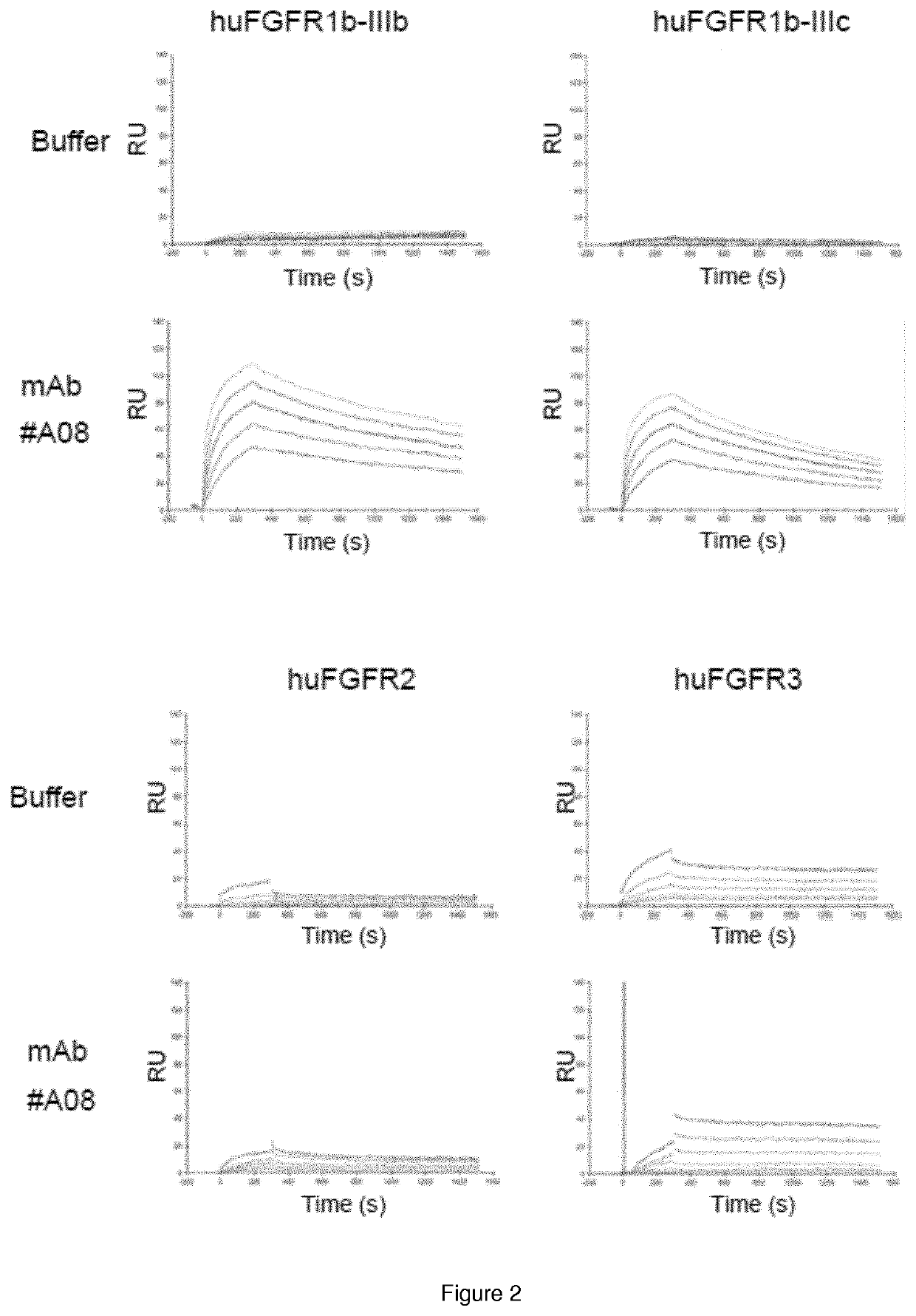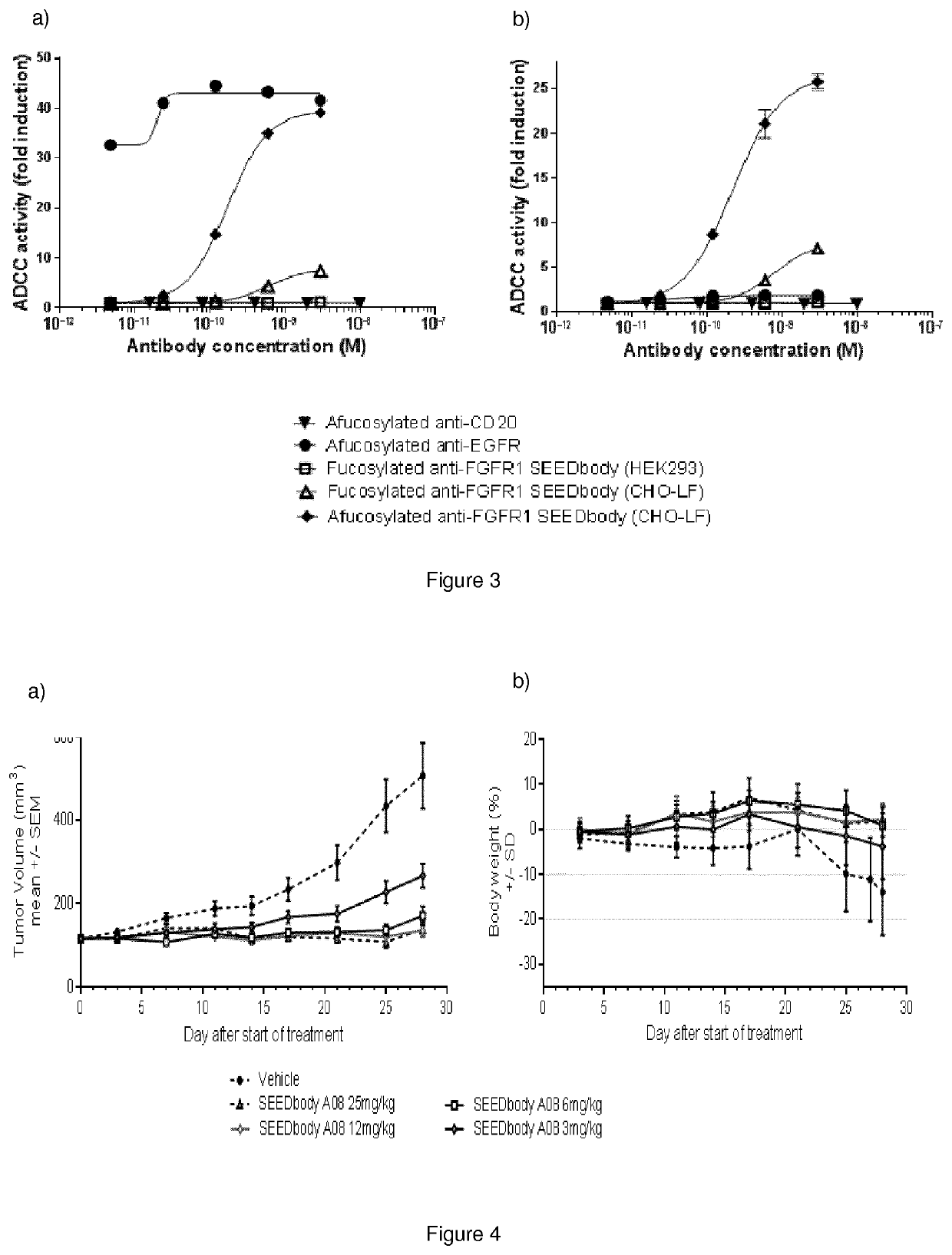Monoclonal antibody directed to fgfr1
a monoclonal antibody and antibody technology, applied in the field of monoclonal antibodies, can solve the problem that no effective anti-cancer drug targeting fgfr1 has reached the mark
- Summary
- Abstract
- Description
- Claims
- Application Information
AI Technical Summary
Benefits of technology
Problems solved by technology
Method used
Image
Examples
example 1
n and Characterization of Anti-FGFR1 Antagonist Antibodies
1.1 Generation of Transient and Stable Expressing Human and Mouse FGFR1
[0085]The cDNAs encoding the extracellular domains of human and mouse FGFR1b-IIIb and FGFR1b-IIIc respectively based on NCBI reference NP_075594, NP_056934 (respectively SEQ ID NO: 80 to SEQ ID NO: 83), were generated by gene synthesis with a C-terminal 6-Histidin tag. The cDNAs were subcloned into mammalian expression vector pVAC2 vector (InvivoGen) to encode FGFR1 protein fused to GPI anchoring domain of the placental alkaline phosphatase.
[0086]Expi293 cells were transfected using Expifectamine (Thermofischer) and CHO cells were transfected using a Nucleofector II Device (Amaxa Biosystems) with the vector encoding the using the Nucleofection system and followed by selection with hygromycin B. Minipools were screened for FGFR1 expression using FACS. Single cells were sorted from best minipools by FACS and expanded. Selection of the clone with highest expr...
example 2
ion of mAb #A08 and mAb #A05
2.1 Heavy and Light Chain Variants
[0102]The amino acid sequences of the variable regions of the mAb #A08 and mAb #A05 heavy (SEQ ID NO: 1 and SEQ ID NO: 26 respectively; VH) and of the variable regions of the mAb #A08 and mAb #A05 light (SEQ ID NO: 2 and SEQ ID NO: 28 respectively; VL) chains were separately modified, by altering both framework region and CDR sequences in the heavy and light chain variable regions. The purpose of these sequence alterations was either to mutate framework amino acid residues to the most homologous human germline residue found at that position, to increase potency in relevant cellular assay, to improve manufacturability of the molecule by preventing Asp isomerization, Asn deamidation and Met oxidation, or to deplete the antibody of in silico identified human T-cell epitopes, thereby reducing or abolishing immunogenicity in humans.
[0103]Two heavy chain variants (SEQ ID NO: 24, and SEQ ID NO: 27) were constructed, as a human I...
example 3
Production and Testing
3.1 Bioproduction, Clarification and Purification
[0115]The monovalent SEEDbody #A08, having amino acid sequences corresponding to SEQ ID NO: 46 and SEQ ID NO: 41 (heavy chains) and SEQ ID NO: 50 (light chain), was produced from CHO-LF cells (generating afucosylated protein for enhanced ADCC). Cell cultures were conducted in batch mode in a 250L Single-use Bioreactor. Cells were grown in proprietary-CHO fed-batch growth media supplemented with glucose at 37° C. The cultures were fed with a mixture of proprietary feed components on days 3, 5, 7 and 10 days post inoculation.
[0116]Crude conditioned media from the bioreactor runs were clarified using 2.2 m2 Millistak+Pod DOHC (Millipore MD0HC10FS1) and 1.1 m2 Millistak+Pod XOHC (Millipore #MX0HC01FS1) filters, followed by terminal filtration with a Millipore Opticap XL3 0.5 / 0.2 μm filter (Millipore #KHGES03HH3).
[0117]The SEEDbody was then purified using standard methods and formulated in 10 mM histidine. This SEEDbo...
PUM
| Property | Measurement | Unit |
|---|---|---|
| flow rate | aaaaa | aaaaa |
| concentrations | aaaaa | aaaaa |
| concentrations | aaaaa | aaaaa |
Abstract
Description
Claims
Application Information
 Login to View More
Login to View More - R&D
- Intellectual Property
- Life Sciences
- Materials
- Tech Scout
- Unparalleled Data Quality
- Higher Quality Content
- 60% Fewer Hallucinations
Browse by: Latest US Patents, China's latest patents, Technical Efficacy Thesaurus, Application Domain, Technology Topic, Popular Technical Reports.
© 2025 PatSnap. All rights reserved.Legal|Privacy policy|Modern Slavery Act Transparency Statement|Sitemap|About US| Contact US: help@patsnap.com



